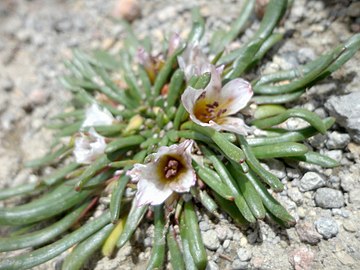
Scaevola is a genus of flowering plants in the Goodenia family, Goodeniaceae. It consists of more than 130 species, with the center of diversity being Australia and Polynesia. There are around 80 species in Australia, occurring throughout the continent, in a variety of habitats. Diversity is highest in the South West, where around 40 species are endemic.
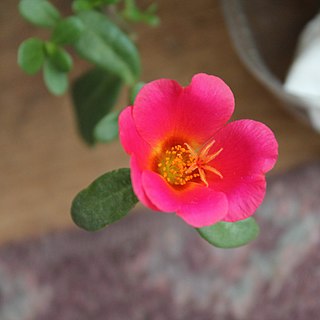
Portulaca is a genus of flowering plants in the family Portulacaceae, and is the type genus of the family. With over 100 species, it is found in the tropics and warm temperate regions. Portulacas are also known as the purslanes.

The Portulacaceae are a family of flowering plants, comprising 115 species in a single genus Portulaca. Formerly some 20 genera with about 500 species, were placed there, but it is now restricted to encompass only one genus, the other genera being placed elsewhere. The family has been recognised by most taxonomists, and is also known as the purslane family. It has a cosmopolitan distribution, with the highest diversity in semiarid regions of the Southern Hemisphere in Africa, Australia, and South America, but with a few species also extending north into Arctic regions. The family is very similar to the Caryophyllaceae, differing in the calyx, which has only two sepals.

Terminalia is a genus of large trees of the flowering plant family Combretaceae, comprising nearly 300 species distributed in tropical regions of the world. The genus name derives from the Latin word terminus, referring to the fact that the leaves appear at the very tips of the shoots.

Calceolaria, also called lady's purse, slipper flower and pocketbook flower, or slipperwort, is a genus of plants in the family Calceolariaceae, sometimes classified in Scrophulariaceae by some authors. This genus consists of about 388 species of shrubs, lianas and herbs, and the geographical range extends from Patagonia to central Mexico, with its distribution centre in Andean region. Calceolaria species have usually yellow or orange flowers, which can have red or purple spots. The Calceolaria Herbeohybrida group, also called C. herbeohybrida Voss, is a group of ornamental hybrids known only in cultivation, called florists' slipperwort.

Senna, the sennas, is a large genus of flowering plants in the legume family. This diverse genus is native throughout the tropics, with a small number of species in temperate regions. The number of species is estimated to be from about 260 to 350. The type species for the genus is Senna alexandrina. About 50 species of Senna are known in cultivation.

Talinum is a genus of herbaceous succulent plants in the family Talinaceae whose common names include fameflower. It includes 27 species native to tropical and subtropical regions of the Americas, sub-Saharan Africa, the Arabian Peninsula, Indian subcontinent, and Myanmar. Several species bear edible leaves, and Talinum fruticosum is widely grown in tropical regions as a leaf vegetable. Talinum paniculatum is grown as an ornamental plant.
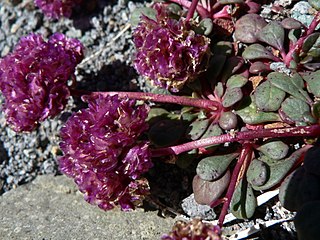
Cistanthe is a plant genus which includes most plants known as pussypaws. These are small, succulent flowering plants which often bear brightly colored flowers, though they vary quite a bit between species in appearance. Some species have flowers that are tightly packed into fluffy-looking inflorescences, the trait that gives them their common name.

Trianthema is a genus of flowering plants in the ice plant family, Aizoaceae. Members of the genus are annuals or perennials generally characterized by fleshy, opposite, unequal, smooth-margined leaves, a prostrate growth form, flowers with five perianth segments subtended by a pair of bracts, and a fruit with a winged lid. The genus contains about 30 described species growing in tropical and subtropical regions, especially Australia. One common species, Trianthema portulacastrum, desert horse purslane, is frequent as a weed in agricultural areas and is widely distributed.
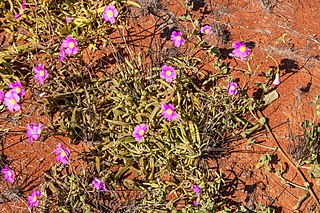
Rumicastrum calyptratum, the pink purslane or small-leaved parakeelya, is an annual plant in the family Montiaceae. It is endemic to Australia.
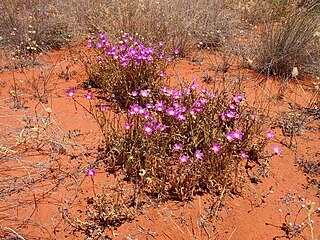
Parakeelya balonensis is a species of succulent plant native to arid and semi-arid regions of Australia. Common names for the plant include parakeelya, broad-leaf parakeelya, broad-leaved parakeelya and Balonne parakeelya. Parakeelya derives from one of the many Aboriginal Australian names for the plant. The scientific name for the species comes from the Balonne River in Queensland, where the first specimen was found. Calandrinia, its former genus, is named for Jean Louis Calandrini, a 19th-century Genevan professor and botanical author, P. balonensis is marketed as a garden plant under the name Calandrinia ‘Mystique’.
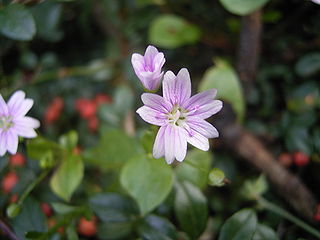
Montiaceae are a family of flowering plants, comprising about 14 genera with about 230 known species, ranging from small herbaceous plants to shrubs. The family has a cosmopolitan distribution.

Rumicastrum corrigioloides is an annual herb in the family Montiaceae, and is native to Western Australia, South Australia, and Victoria.

Rumicastrum granuliferum is an annual herb in the family Montiaceae, and is native to New South Wales, Tasmania, Western Australia, South Australia, and Victoria.

Parakeelya is a genus of plants in the family Montiaceae with species native to Australia and New Guinea. These species were formerly classed in genus Calandrinia, which was discovered to be paraphyletic.

